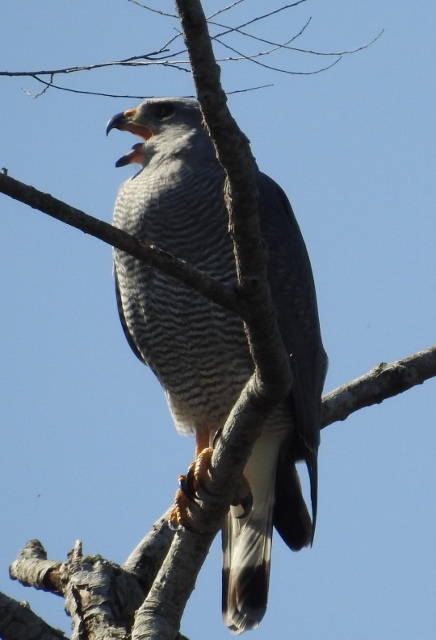by M. Kathy Raines

The elegant raptor, its chest adorned in alternating white and cloud-gray scallops, sat on a bare willow branch along the boardwalk one December afternoon at Sabal Palms Wildlife Sanctuary. Beak ajar, it repeatedly cried out a high-pitched WheEEEooo!
What a treat! Had the hawk sat silently, I might not have noticed it; I had been scanning the brush for a snake, preferably a speckled racer. Soon the hawk sailed off into low brush, squealing. Then it fluttered to the same perch. Almost directly beneath, I took photo-after-photo. I departed before it did.
This stunning gray hawk called to mind someone in a stylish houndstooth suit. Its chest is barred pale gray and white while its back is solid gray. A medium-sized hawk, it has comparatively short wings with dark tips and a long black-and-white striped tail that is white underneath. Juveniles, which look quite different, have brownish colors rather than gray, cream-colored cheeks and dark eye lines.
The gray hawk’s sturdy yellow-orange legs end in four curved talons sheathed in keratin, its longest one, the hallux, on its hind toe. With these, the bird catches, kills and secures prey. Its bill is black, the upper section hooked and razorblade sharp for slicing flesh. Its cere, a waxy area above the beak, is orangish-yellow.
The female resembles the male, but, like most hawks, she is noticeably larger. This might be so she can more successfully defend her nest from large predators like raccoons and other hawks while the slighter males seek small prey for chicks.
Reptiles, especially whiptail and spiny lizards, constitute about 80% of a gray hawk’s diet, but it also eats mice, rats, small rabbits, ground squirrels and large insects. A gray hawk sits upright on a tree or utility line and, with keen hearing and eyesight, scans its surroundings for prey. Then it deftly circles through the lower canopy, plucking lizards off limbs, trunks, leaves and soil.
Gray hawks, being tropical birds, appear only as north as southern Arizona, Texas, and, upon occasion, New Mexico. In autumn, birds north of the Valley migrate south where their favored prey remains plentiful.
The hawks, with their preference for reptiles, thrive in thornscrub—dry areas full of short trees, shrubs and cacti—and forests near streams, especially those with mesquite, cottonwood and hackberry.
The gray hawk (Buteo plagiatus), sometimes called “Mexican goshawk” for its resemblance to the northern goshawk, has previously borne two different scientific names. A reference book published earlier than 2015 will call it “Buteo nitidud”—which now denotes only the gray-lined hawk— or “Asturina nitida”. “Buteo” derives from a Latin name for “buzzard”, which is an Old-World bird of prey. The gray hawk’s species name, “plagiatus”, is Latin for “kidnapped”.
Gray hawks, which are usually monogamous, form pairs upon arriving in breeding territory. During courtship, males, and sometimes females, circle high, then plummet, calling in repeated, descending whistles. They usually nest high in trees, often cottonwoods, in dense or open woods. But, interestingly, gray hawks occasionally nest in public areas like Anzalduas Park near Mission, which picnickers frequent, apparently undaunted by them. The couple builds a shallow, 18-inch-wide nest of fresh sticks, lined with foliage and concealed by leaves. The female primarily shapes the nest, while the male supplies most materials.
The female lays from one-to-three bluish-white eggs in early-to-late May, which she alone incubates. Downy chicks with whitish heads, grayish-brown backs and a streak behind each eye hatch in from 32-to-34 days.
Both parents feed hatchlings, which fledge in about 72 days. When chicks are threatened, worried parents cry out in a “creeer”, while fledglings make a more strident, broken sound. Gray hawks raise one brood per season, and the young tend to remain close by after they fledge. By the first autumn, young hawks are independent, and they molt, or shed, then regrow adult feathers their second fall or winter.
Gray hawks fly low through forests with three flaps, then a glide. Unlike most buteos, they do not soar high or for lengthy periods. Seemingly less wary than many hawks, they occasionally appear in suburban areas, perched on fences and branches. The hawk whistles a three-note call during the breeding season to attract and maintain mates and define territories. Gray hawks sometimes give a one-note alarm call during hunting or quarrels.
While common in the tropics, Audubon denotes gray hawks as “uncommon” in the Southwest, noting that likely no more than 50 pairs nest here. Twice at Sabal Palms I observed gray hawks perched, vocalizing while watching for prey, then swooping down, once in early December along the boardwalk, and later in the month, at Dave’s Blind. They are vulnerable to the loss of low woodland streams. However, UTRGV professor Timothy Brush, author of Nesting Birds of a Tropical Frontier, believes that gray hawk populations “are increasing, slowly but surely.”
UTRGV graduate student Michael Stewart, under Brush’s mentorship, is embarking on a thorough study of gray hawks, about which, he says, we have “knowledge gaps” that he and his colleagues are “hoping to fill in.” These studies will entail banding, analyzing and releasing birds and studying previously banded ones. Also, Stewart says, “I have 30 OrniTrack-10 transmitters from Ornitela, and we hope to deploy all 30 of them.” These, he said, “use the cellular network to transmit data that we can download online to analyze.”
The Valley hosts a gray hawk population which, unlike those in other areas, does not migrate, Stewart said. He suspects this hawk’s population is growing and its range expanding but adds, “Habitat destruction is a major challenge for countless species, gray hawk included.” But he notes that the hawks have an “ability to nest in urban areas,” which may bode well for their survival, as “they may end up being more adaptable than many species.”
